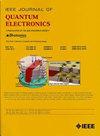抗欺骗攻击的时bin相位编码量子安全激光雷达
IF 2.1
3区 工程技术
Q3 ENGINEERING, ELECTRICAL & ELECTRONIC
引用次数: 0
摘要
强大和安全的测距对于许多光探测和测距(LiDAR)应用至关重要。然而,传统的激光雷达系统容易受到欺骗干扰,例如拦截和重发欺骗攻击,因为它们使用经典信号来询问非合作目标。虽然已经提出了量子安全成像协议来对抗这些攻击,但实际模型却很少。本文提出了一种量子安全激光雷达协议,该协议使用时间bin相位编码量子态进行同步测距和安全评估。测距是通过相互关联的信号完成的,安全评估是通过统计分析错误率完成的。我们开发了一个分析模型来评估系统对拦截重发欺骗攻击的弹性,通过数值模拟证明,在某些条件下,这种攻击可以以高概率和低误报率被检测到。该方案对极化干扰和相位漂移具有鲁棒性,可以利用现有技术实现,这表明其在量子雷达应用中具有提高光学测距和成像系统安全性和可靠性的潜力。本文章由计算机程序翻译,如有差异,请以英文原文为准。
Time-Bin Phase-Encoding Quantum-Secured LiDAR Against Spoofing Attacks
Robust and secure ranging is essential for numerous light detection and ranging (LiDAR) applications. Traditional LiDAR systems, however, are susceptible to deception jamming, such as intercept-and-resend spoofing attacks, due to their use of classical signals for interrogating non-cooperative targets. While quantum-secured imaging protocols have been proposed to counter these attacks, practical models have been scarce. This paper presents a quantum-secured LiDAR protocol using time-bin phase-encoded quantum states for simultaneous ranging and security assessment. Ranging is done via cross-correlating signals, and security assessment by statistically analyzing error rates. We develop an analytical model to evaluate the system’s resilience against intercept-resend spoofing attacks, demonstrating through numerical simulations that such attacks can be detected with high probability and low false-alarm rates under certain conditions. The scheme is robust against polarization disturbances and phase drifts, and can be implemented using existing technology, signifying its potential in quantum radar applications to improve the security and reliability of optical ranging and imaging systems.
求助全文
通过发布文献求助,成功后即可免费获取论文全文。
去求助
来源期刊

IEEE Journal of Quantum Electronics
工程技术-工程:电子与电气
CiteScore
4.70
自引率
4.00%
发文量
99
审稿时长
3.0 months
期刊介绍:
The IEEE Journal of Quantum Electronics is dedicated to the publication of manuscripts reporting novel experimental or theoretical results in the broad field of the science and technology of quantum electronics. The Journal comprises original contributions, both regular papers and letters, describing significant advances in the understanding of quantum electronics phenomena or the demonstration of new devices, systems, or applications. Manuscripts reporting new developments in systems and applications must emphasize quantum electronics principles or devices. The scope of JQE encompasses the generation, propagation, detection, and application of coherent electromagnetic radiation having wavelengths below one millimeter (i.e., in the submillimeter, infrared, visible, ultraviolet, etc., regions). Whether the focus of a manuscript is a quantum-electronic device or phenomenon, the critical factor in the editorial review of a manuscript is the potential impact of the results presented on continuing research in the field or on advancing the technological base of quantum electronics.
 求助内容:
求助内容: 应助结果提醒方式:
应助结果提醒方式:


